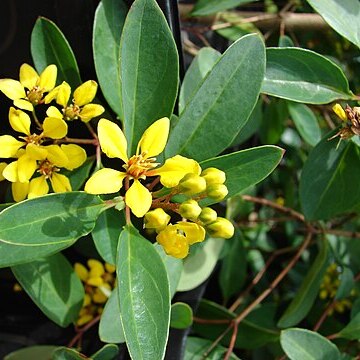Shrubs, small trees, or woody lianas, pubescence a mix of medifixed (T-shaped) and simple hairs, monoecious or andro-dioecious. Leaves usually opposite, rarely alternate or 3-whorled, petiolate, simple, entire, glands often present either on petiole or on lower surface of leaves; stipules free and deciduous, or connate and ± persistent, sometimes reduced or absent. Inflorescences terminal or axillary, racemose, corymbose or umbellate, solitary or in panicles; pedicels articulate, 2-bracteolate at point of attachment. Flowers bisexual or staminate (in Ryssopterys), actinomorphic or zygomorphic. Sepals 5, polysepalous or gamosepalous, imbricate, rarely valvate, one or more large glandular at bases of outside members, rarely eglandular. Petals 5, typically clawed, margin ciliate, dentate or fimbriate. Disk inconspicuous. Stamens 10, obdiplostemonous, sometimes diadelphous with one stamen distinctly larger than others; filaments usually connate at base; anthers introrse, longitudinally dehiscent. Ovary superior, 3-locular, placenta axile, 1-ovuled, pendulous and semianatropous in each locule; styles 3, or connate into 1, persistent. Fruit a schizocarp, carpels 3 or fewer, 1 seed per carpel; schizocarp splitting into winged samaras, indehiscent. Seed embryo large, erect or rarely curved; endosperm lacking.
Mostly woody climbers, sometimes shrubs or small trees, with unicellular appressed (sometimes fork-shaped) medifixed ± stiff hairs. Leaves opposite, ternate or alternate, simple and entire, often with glands near the base of the lamina or on the petiole; stipules present or absent. Inflorescence terminal or axillary, usually many-flowered and racemose (or more rarely flowers solitary); bracts and bracteoles present. Flowers actinomorphic or zygomorphic, bisexual (in African genera). Sepals 5, free or connate at the base, persistent, often with glands outside. Petals 5, frequently clawed, free, imbricate, entire or with fringed or dentate margins. Stamens 10, with those of the outer series opposite the petals; filaments often connate at the base; anthers dehiscing longitudinally, introrse, basifixed or dorsifixed, 2-thecous. Ovary superior, syncarpous, 3(rarely 2, 4, or 5)-locular and-lobed, with 1 pendulous axile ovule in each locule; styles as many as the carpels with usually entire stigmas. Fruit a schizocarp, usually winged (samara), rarely a fleshy drupe. Seeds with a large usually straight embryo, without endosperm
Ovary superior, syncarpous, 3 (rarely 2, 4, or 5)-locular and-lobed, with 1 pendulous axile ovule in each loculus; styles as many as the carpels, with usually entire stigmas
Stamens 10, obdiplostemonous, with filaments often connate at the base; anthers dehiscing longitudinally, introrse, basifixed or dorsifixed, 2-thecous
Leaves opposite, ternate or alternate, simple and entire, often with glands near the base of the lamina or on the petiole; stipules present or absent
Leaves opposite or rarely alternate, simple; a pair of glands often present at the base of the blade; stipules present or absent, sometimes connate
Inflorescence terminal or axillary, usually many-flowered and racemose (or more rarely flowers solitary); bracts and bracteoles present
Mostly woody climbers, sometimes shrubs or small trees, with unicellular appressed (sometimes V-shaped) medifixed ± stiff hairs
Carpels usually 3, free or connate into a 3-celled ovary; cells 1-ovuled; styles usually separate and spreading
Stamens 10, hypogynous; filaments free or connate at the base; anthers 2-celled, opening lengthwise
Petals 5, frequently unguiculate, free, imbricate, entire or with fringed or dentate margin
Seeds without endosperm and with straight, curved or uncinate, rarely circinate embryo
Fruiting carpels mostly winged or carpels connate into a fleshy or woody drupe
Sepals 5, free or connate at the base, persistent, often with dorsal glands
Trees, shrubs or climbers, usually clothed with appressed medifixed hairs
Flowers actinomorphic or zygomorphic, bisexual (in African genera)
Fruit a schizocarp, usually winged (samara), rarely a fleshy drupe
Sepals 5, imbricate or rarely valvate, often biglandular outside
Seeds with a large usually straight embryo, without endosperm
Flowers mostly hermaphrodite, actinomorphic
Petals 5, clawed
Disk small

